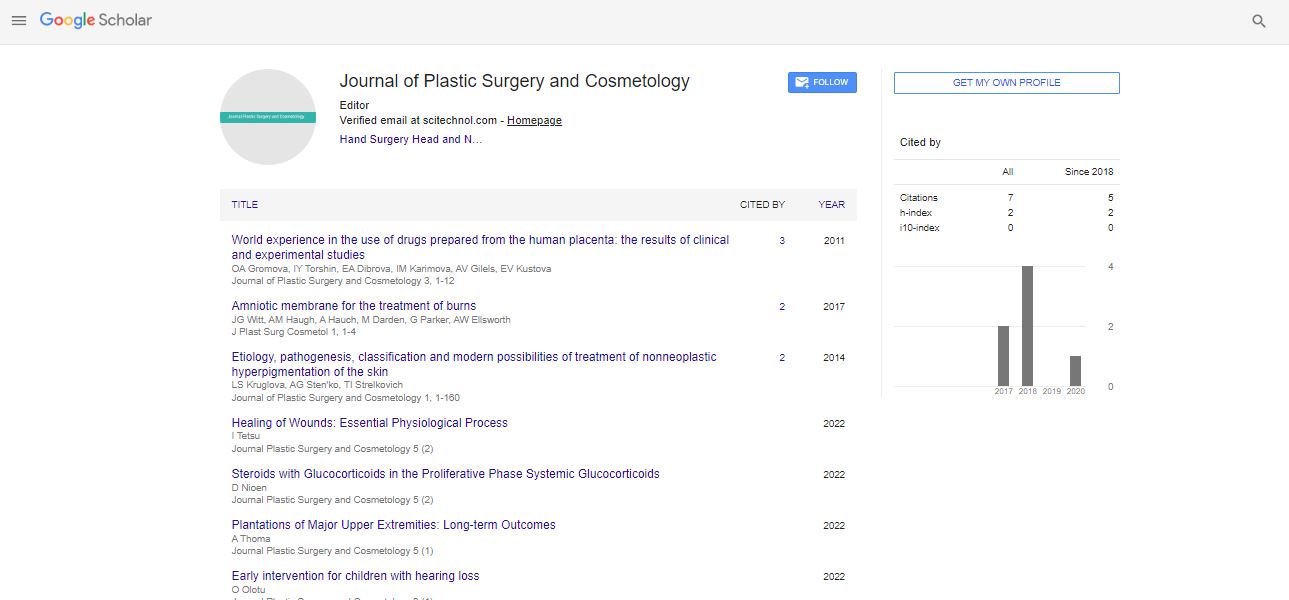Opinion Article, J Pls Sur Cos Vol: 12 Issue: 2
Exploring Non-Invasive Aesthetic Procedures: Effectiveness, Safety, and Contemporary Trends
Rezaei Khoong*
Department of Plastic Surgery, Helsinki University Hospital, Helsinki, Finland
*Corresponding Author: Rezaei Khoong,
Department of Plastic Surgery, Helsinki University Hospital, Helsinki, Finland;
E-mail: Khoongzaei99@hotmail.com
Received date: 29 May, 2023, Manuscript No. JPSC-23-106757;
Editor assigned date: 31 May, 2023, PreQC No. JPSC-23-106757(PQ);
Reviewed date: 14 June, 2023, QCNo JPSC-23-106757;
Revised date: 21 June, 2023, Manuscript No. JPSC-23-106757(R);
Published date: 30 June, 2023, DOI: 10.4172/JPSC.100047
Citation: Khoong R (2023) Exploring Non-Invasive Aesthetic Procedures: Effectiveness, Safety, and Contemporary Trends. J Pls Sur Cos 12:2.
Description
Non-surgical cosmetic procedures have gained popularity as effective alternatives to surgical interventions, offering individuals the opportunity to enhance their appearance without undergoing invasive surgery. This study explores the various non-surgical cosmetic procedures available, including injectable, laser therapy, and noninvasive body contouring. It examines their efficacy, safety profiles, and emerging trends in the field. Understanding the advancements and considerations associated with non-surgical cosmetic procedures allows individuals to make informed decisions about their aesthetic goals.
Non-surgical cosmetic procedures have witnessed a surge in demand due to their accessibility, convenience, and reduced downtime compared to surgical interventions. This study highlights the significance of non-surgical procedures and their impact on the field of cosmetology.
Types of non-surgical cosmetic procedures
Injectables: Injectable treatments, such as Botulinum Toxin (Botox) and dermal fillers are widely used to diminish wrinkles, restore volume, and enhance facial features. These procedures offer immediate results with minimal discomfort and downtime.
Laser and light-based therapies: Laser therapy and other light-based treatments target specific skin concerns, including pigmentation, acne scars, and signs of aging. They stimulate collagen production, improve skin texture, and promote overall rejuvenation.
Non-invasive body contouring: Non-invasive body contouring procedures, such as cryolipolysis (fat freezing) and radiofrequencybased treatments, aim to reduce localized fat deposits, tighten the skin, and improve body shape without surgery.
Efficacy and safety considerations
Efficacy of non-surgical procedures: Non-surgical cosmetic procedures have demonstrated efficacy in addressing specific aesthetic concerns, such as fine lines, wrinkles, volume loss, and body contour irregularities. Results vary depending on the procedure, individual factors, and treatment adherence.
Safety profiles and potential side effects: While non-surgical procedures generally have a favorable safety profile, potential side effects may include temporary bruising, swelling, redness, or rare adverse events. It is essential to consult with a qualified professional and disclose relevant medical history to ensure optimal safety.
Emerging trends in non-surgical cosmetology
Combination therapies: Combining multiple non-surgical procedures or modalities is becoming increasingly popular to achieve comprehensive aesthetic improvements. Synergistic effects can be achieved by addressing different aspects of facial rejuvenation or body contouring simultaneously.
Minimally invasive techniques: Advancements in non-surgical techniques have led to the development of minimally invasive procedures. These include thread lifts, laser resurfacing, and ultrasound-assisted treatments, which provide more significant outcomes than non-invasive options while still avoiding the need for extensive surgery.
Customized treatments: Tailoring non-surgical procedures to individual needs and goals is gaining importance. Personalized treatment plans allow for targeted improvements and a more naturallooking outcome, aligning with the patient's unique facial or body characteristics.
Considerations and precautions
Choosing a qualified provider: Selecting a qualified and experienced provider is important to ensure optimal outcomes and minimize potential risks associated with non-surgical procedures. Proper training and adherence to ethical guidelines are essential for safe and effective treatments.
Realistic expectations and maintenance: Understanding the limitations of non-surgical procedures and having realistic expectations is vital. Maintenance treatments may be necessary to sustain the desired outcomes, as the effects of non-surgical procedures are generally temporary.
Conclusion
Non-surgical cosmetic procedures have revolutionized the field of cosmetology, offering individuals a range of options for aesthetic enhancement without undergoing surgery. These procedures have proven efficacy and safety when performed by qualified professionals. As the field continues to advance, emerging trends and individualized approaches are shaping the future of non-surgical cosmetic procedures. By being well-informed and considering the associated considerations and precautions, individuals can make informed decisions to achieve their desired aesthetic goals effectively and safely.
 Spanish
Spanish  Chinese
Chinese  Russian
Russian  German
German  French
French  Japanese
Japanese  Portuguese
Portuguese  Hindi
Hindi 